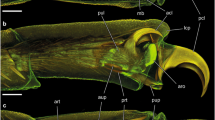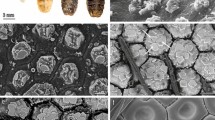Summary
The epicuticle of adult Tenebrio consists of two distinct layers named outer and inner epicuticle.
The outer epicuticle is the first cuticular layer to be deposited in form of small patches on top of the microvilli. These initial patches are composed of four dense laminae (A, B, C1 and C2) separated by three light spaces. The outer epicuticle grows by densification of diffuse material at the edges of the patches until the entire area is covered.
The thickness of outer epicuticle remains constant (175 Å) during the development of the pharate adult, lamina B however rapidly disappears. Thus, the adult outer epicuticle is fivelayered (three dense laminae: A, C1 and C2).
After being deposited, the inner epicuticle shows a complex laminar structure interpreted to represent a highly organized molecular system. The laminae are masked during the formation of the first procuticle lamellae.
During the deposition of the epicuticle, lamina A is covered by a component of the moulting fluid, forming an irregular dense layer which disappears after the resorption of this fluid. Perhaps this layer protects the new epicuticle from lytic enzymes of the moulting fluid.
In adult animals, there is an additional superficial layer, the signification of which is not clear. The possibility of remains of cement or wax is discussed.
The development of the surface patterns of the sternal and pleural cuticle is determined before the epicuticle formation by the shape of the epidermal surface. The rate of outer epicuticle deposition appears to depend on the size of the microvilli: epicuticle deposition seems to proceed faster over high microvilli.
Résumé
L'épicuticule de l'adulte de Tenebrio molitor est composée de deux couches distinctes dénommées épicuticule externe et épicuticule interne. L'épicuticule externe est la première couche cuticulaire sécrétée sous forme de petites plaques s'agrandissant par leurs bords pour recouvrir toute la surface cellulaire. Au moment de sa sécrétion, cette couche est formée de quatre lames denses A, B, C1 et C2. La lame B, très fine, disparaît par la suite et les lames C1 et C2 deviennent très nettes. L'épicuticule externe de l'adulte est donc formée de trois lames denses séparées par deux lames claires.
L'épicuticule interne est formée de lames superposées denses et claires de structure complexe, qui sont masquées pendant la sécrétion des premières couches de cuticule lamellée (procuticule). Cette structure correspond à un arrangement moléculaire hautement organisé.
La forme de la surface cuticulaire des sternites est déterminée par la forme de la surface cellulaire avant le dépôt de l'épicuticule.
Similar content being viewed by others
Bibliographie
Anderson, W. A., Ellis, R. A.: Ultrastructure of Trypanosoma lewisi: flagellum, microtubules and the kinetoplast. J. Protozool. 12, 483–499 (1965).
Baker, G., Pepper, J. H., Johnson, L. H., Hastings, E.: Estimation of the composition of the cuticular wax of the mormon cricket, Anabrus simplex Hald. J. Ins. Physiol. 5, 47–60 (1960).
Beament, J. W. L.: Wax secretion in the cockroach. J. exp. Biol. 32, 514–538 (1955).
Beaulaton, J.: Modifications ultrastructurales des trachées et genèse des petites trachées et trachéoles chez le ver à soie. J. Microscopie 7, 621–646 (1968).
Bernard, G. D., Miller, W. H.: Interference filters in the cornea of diptera. Invest. Ophtal. 7, 416–434 (1968).
Bordereau, C.: Membranes intersegmentaires et pleurales des imagos de Termites supérieurs (Isoptera, Termitidae): dimorphisme sexuel, ultrastructure et histochimie, relations avec la physogastrie de la Reine. Thèse de 3 ème Cycle Entomologie. Dijon 1968.
Dennell, R., Malek, S. R. A.: Homology of the layers of the epicuticle of insects. Nature (Lond.) 171, 298 (1953).
—: The cuticle of the cockroach, Periplaneta americana. Proc. roy. Soc. B 143, 239–257 (1955).
Filshie, S. K., Waterhouse, D. F.: The structure and development of a surface pattern of the cuticle of the green vegetable bug Nezara viridula. Tissue and Cell 1, 317–385 (1969).
Furneaux, P. J. S., James, C. R., Potter, S. A.: The egg-shell of the house cricket Acheta domesticus: an electron microscopical study. J. Cell Sci. 5, 227–249 (1969).
Gilby, A. R., Cox, M. E.: The cuticular lipids of the cockroach, Periplaneta americana (L.). J. Ins. Physiol. 9, 671–682 (1963).
Gluud, A.: Zur Feinstruktur der Insektencuticula. Ein Beitrag zur Fräge des Eigengiftschutzes des Wanzencuticula. Zool. Jb., Abt. Anat. 85, 191–227 (1968).
Jenkin, P. M., Hinton, H. E.: Apolysis in Arthropod moulting cycles. Nature (Lond.) 221, 871 (1966).
Jeuniaux, C.: Chitine et chitinolyse. 181 p. Paris: Masson & Cie. 1963.
Locke, M.: The structure and formation of the integument in insects. In: Rockstein, The physiology of insecta, vol. III, p. 379–470. New York: Academic Press 1964.
—: The structure and formation of the cuticulin layer in the epicuticle of an insect, Calpodes ethlius (Lep. Hesp.). J. Morph. 118, 461–494 (1966).
—: The structure of an epidermal cell during the development of the protein epicuticle and the uptake of molting fluid in an insect. J. Morph. 127, 7–40 (1969).
Lower, H. F.: The insect epicuticle and its terminology. Ann. entomol. Soc. Amer. 52, 381–385 (1959).
Noirot, Ch., Noirot-Timothée, C.: La cuticule proctodéale des Insectes, I: Ultrastructure comparée. Z. Zellforsch. 101, 477–509 (1969).
- - La cuticule proctodéale des Insectes, II: Formation pendant la mue. A paraître.
Paweletz, N., Schlote, F. W.: Periodische Muster auf der Flügelschuppe von Ephestia kühniella Z. und ihre Entstehung. Verh. dtsch. zool. Ges. Kiel 273 (1964a).
—: Die Entwicklung der Schmetterlingsschuppe bei Ephestia kühniella Zeller. Z. Zellforsch. 63, 840–870 (1964b).
Richards, A. G.: The integument of arthropods. Minnesota Press, Mineapolis Univ. 411 p. 1951.
—: Studies on arthropod cuticle. XIII: The penetration of dissolved oxygen and electrolytes in relation to the multiple barriers of the epicuticle. J. Ins. Physiol. 1, 23–39 (1957).
—: The cuticle of Arthropods. Ergbn. Biol. 20, 1–26 (1958).
Rudall, K. M.: Skeletal structure in insects. Biochem. Soc. Symp. G. B. 25, 83–92 (1965).
Sjöstrand, F. S.: Electron microscopy of cells and tissues, vol. I. New York: Academic Press 411 p. 1967.
Way, M. J.: The structure and development of the larval cuticle of Diataraxia oleracea (Lep.). Quart. J. micr. Sci. 91, 145–182. (1950).
Wigglesworth, V. B.: The physiology of the cuticle and of ecdysis in Rhodnius prolixus with special reference to the functions of the oenocytes and the dermal glands. Quart. J. micr. Sci. 76, 269–318 (1934).
—: The epicuticle of an insect Rhodnius prolixus. Proc. roy Soc. B 134, 163–181 (1947).
—: The structure and deposition of the cuticle in the adult mealworm: Tenebrio molitor L. Quart. J. micr. Sci. 89, 197–217 (1948).
—: The physiology of insect cuticle. Ann. Rev. Ent. 2, 37–54 (1957).
Author information
Authors and Affiliations
Additional information
Nous tenons à remercier notre directeur de recherche, le Professeur Noirot pour ses encouragements et ses conseils et Madame Curie pour son aide technique efficace.
Rights and permissions
About this article
Cite this article
Delachambre, J. Etudes sur l'épicuticule des insectes. Z. Zellforsch. 108, 380–396 (1970). https://doi.org/10.1007/BF00336526
Received:
Issue Date:
DOI: https://doi.org/10.1007/BF00336526




